 |
|
| Retrogaming
Times Monthly |
| Issue #56 - January 2009 |
|
Table of Contents |
|
| 01. | Attract Mode |
| 02. | Old Wine in New Bottles #12 |
| 03. | RTM Idiocy |
| 03. | Apple II Incider - Donkey Kong and Pac Man |
| 04. | The ZX81 |
| 05. | Game Over |

Attract Mode
by Eric T. Schuetz
Happy New Years to you all! With a new year, comes a new Editor in Chief of RTM! I volunteered to pick up the riegns of this fine e-zine, and am quickly realizing that this is NOT going to be easy. However, anything worth doing is never easy. It will be fun, though. I look foreward to helping produce one of the longest running retrogaming e-zines on the internet. I am hoping to inject something new into the tried and true format that RTM has come to know. I am not, however, one that feels the need to change just for the sake of changing. This isse will be "more of the same", as I don't want to make a lot of sudden changes to the format, as I am not a fan of seeing my favorite websites and such just up and change on me. Anywho, this issue will be a tad bit shorter than what we all would like, but with the holiday season behind us now, we should be seeing bigger issues starting next month.
Well, if you are wondering anything about me, let me introduce myself. I am a video gaming veteran. I have been playing video games since i was about 4 years old going to the local department store playing on the Atari VCS/2600 kiosks while my folks went shopping. I grew up idealizing the wonderous "life like" graphics of the Atari console. Since then, I latched on to any machine I could get hold of, as long as the budget would allow. I have been collecting for a little while now, not letting my babies slip away. I don't have any real "duplicates" in my collection, as right now my goal is to have just "one of each".
My true favorite is always going to be the Atari 2600, but right now, I have been delving deeply into the joys of the Dreamcast. Such a wonderful system. Shame it died so young. We barely new her. In regards to that, my normal articles will mostly cover anything that appeared on the Atari systems, ranging from the VCS to the Jaguar, and let us not forget the Lynx.
But enough of me, let us get on with the first issue of 2009!
The classic game compilation for this month is the Sonic Mega Collection Plus. It was released for the PlayStation 2 in 2004. As the title suggests, it includes the various Sonic games from both the Genesis and the Game Gear. There are also some additional bonus (or filler) titles than can be unlocked. Frustratingly, nowhere in the manual (or in the game itself) are the unlockable games actually listed, or how to unlock them. The complete list of games includes:

Old Wine in New Bottles: Retrogaming on Modern Hardware by Jonathan H. Davidson
All of the Game Gear games are unlocked from the very beginning. Many of these Genesis games were later included in the Sega Genesis Collection (reviewed June 2008 in RTM#49 http://my.stratos.net/%7Ehewston95/RTM49/RTM49.html#OldWine).
As far as I am aware, this is only commercially released emulator for a handheld game system. (I am aware of the various products that Nintendo released to play various generations of Game Boy games on SNES and later the Game Cube, but these are mainly hardware solutions, not emulators as such.)
The graphics on the Genesis games are very sharp. It has been years since I played Sonic on actual hardware, but there are no obvious differences. Sonic 3D Blast is especially impressive; it even holds its own against the quality of graphics on the original PlayStation.
The quality of the Game Gear games, in contrast, is not very good. The graphics are fuzzy; this is especially evident with the racing game Sonic Drift. Most of the Game Gear games are simplified versions of the Genesis games, so this makes the quality comparison even more obvious.
As with most retrogaming collections, there is much bonus content beyond the games themselves. This includes scans of the covers (and a few complete issues) of the Sonic comics series. Other bonus content includes sketches and artists renderings of the Sonic characters from various games, advertising, etc. Finally, there are some movie clips from Sonic Heroes.
One delightful addition to this collection is scanned images of the original game manuals. This is a very frequent weakness with retrogame collections. The emulator allows players to save anytime, even in games where there was originally no save function implemented.
Overall, unless someone is a huge fan of the Sonic series of games, this compilation is definitely much weaker than the Sega Genesis Collection. It is worth picking up from the discount bin, but not at full retail.
Next month, we will review yet another collection of classic games for the PlayStation 2. Feedback on this column is always welcome; please send any comments and/or questions to jhd@interbaun.com.
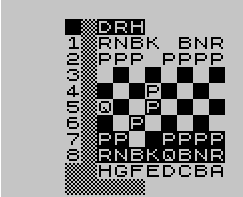
Computer Idiocy RTM #1 by Mark Sabbatini
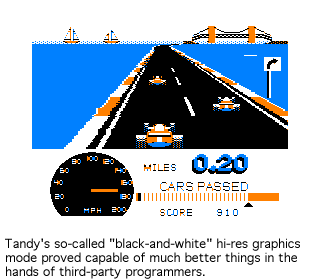
Try selling a car by describing how much better next year's model will be. Or making a profit by selling more vehicles at a loss. Come to think of it, you'd have Detroit. Retrocomputing history is packed with similar legends exploring the boundaries of human stupidity, making writings about old computers one of my favorite forms of literature. Few users need to hear more than E.T., Jr. or Adam to know those episodes of carnage, but a wealth of obscure tales buried in aging magazines, books and online bulletin boards are equally and endlessly entertaining. This new column explores the stacks of boxes I've accumulated over a few decades, beginning with an example or two from various absurdities corporate, published, user to be examined more in-depth later. I'll make the requisite pause in my mockery to acknowledge that thing about hindsight and, to show my intellect was as challenged as anyone, start with the machine perhaps nearest and dearest to me: Tandy's TRS-80 Color Computer. Returning to car metaphors, the company decided to boast it had half its true horsepower. The CoCo, as fans called it, debuted in 1980 with a maximum 32K of memory, a processor running at 0.9Mhz and two-color graphics at the maximum resolution of 256X192, according to catalogues at Tandy's Radio Shack stores. Except the company started using 64K chips early on without telling anyone. Furthermore, users quickly discovered a single POKE statement doubled the CoCo's speed (techies warned the circuitry wasn't designed to blaze along at 1.8Mhz, but it was used widely anyhow). Another POKE allowed four colors plus 252 patterns in hi-res mode. Tandy also drove off nearly all major software companies with hostile policies while fobbing horrible and overpriced in-house stuff onto customers. The computer's main selling point was widespread access to help at any Radio Shack, but lots of customers complained employees knew little about it and/or spent most of their energy selling more expensive models with higher profit margins. Yet somehow the CoCo lasted more than a decade albeit as a second-tier machine while other machines were appearing and vanishing in droves. Tandy was blessed, it seems, by a combination of exaggerated user loyalty and competitors committing even greater acts of folly.
When Tandy introduced a revised and badly buggy Color Computer 3 in 1986, for instance, a letter in The Rainbow (the one CoCo magazine lasting more than a short time) suggested the complaints were just a "bunch of user's mistakes." Similar denial plagued others in the same pages who over the years argued the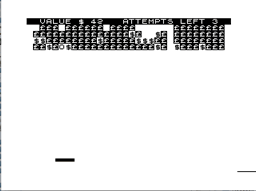 CoCo was superior to the Commodore Amiga, Atari ST series, Macintosh and PC, complete with technical gymnastics explaining how a 1.8Mhz eight-bit processor was faster than, say, an 8Mhz 68000 chip.
CoCo was superior to the Commodore Amiga, Atari ST series, Macintosh and PC, complete with technical gymnastics explaining how a 1.8Mhz eight-bit processor was faster than, say, an 8Mhz 68000 chip.
Not that the magazine did a great job of educating them. Editors were prone to excessive praise, recognizing what was good for Tandy was good for the publication. When Tandy introduced a scaled-down CoCo in 1983 called the MC-10, generally considered one of the worst computers in history ("that's like saying a poor man's VW Beetle," a writer for another magazine scoffed), a technical editor for The Rainbow wrote "I predict that software will be abundant due to the similarity and ties to the Color Computer." Ultimately about 10 programs hit the market, mostly ubiquitous BASIC programs like Pong and Breakout. One of the more entertaining, if useless, sections was software reviews, loaded with things such as game reviews by writers who obviously had never set foot in an arcade. This led to a Gauntlet clone being called an innovative Pac-like game, a Robotron clone being called an adaptation of Berserk and Crystal Castles (an unauthorized clone with the same name as Atari's arcade hit) hailed as a clever original. More than one reviewer exhausted nearly all of their space describing an exciting concept they'd discovered called an "adventure" while barely describing the plot judging it's relative quality was obviously out of the question leading to lots of recommendations for some of the worst titles on the market. At least as amusing was the response to reviews by software companies, who often made themselves look worse than any negative review could. One defended a program's tendency to crash by saying error trapping was left out because it's "often a simple way to dodge hardware errors by having the program ignore them." Another said he should be excused from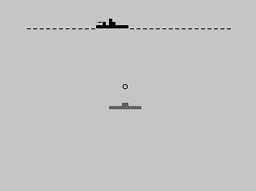 numerous typographical errors in a tax program, of all things because he wasn't a good speller. Still untouched are the misleading and misguided ads, naive political and legal actions, and online BBS board debates preluding the flame wars in every forum and comment section on the Internet. All this and more will get ample coverage in the months to come. Meanwhile, an outstanding book on the most blatant buffoonery of the technical age is "In Search Of Stupidity" by Merrill R. (Rick) Chapman, much of which can be read free at Google Books. It's also available used for less than a dollar at Amazon.com and more material is available at www.insearchofstupidity.com. I'm not shilling for him, but he deserves the plug since it's the inspiration for the more obscure material I'll be covering here.
numerous typographical errors in a tax program, of all things because he wasn't a good speller. Still untouched are the misleading and misguided ads, naive political and legal actions, and online BBS board debates preluding the flame wars in every forum and comment section on the Internet. All this and more will get ample coverage in the months to come. Meanwhile, an outstanding book on the most blatant buffoonery of the technical age is "In Search Of Stupidity" by Merrill R. (Rick) Chapman, much of which can be read free at Google Books. It's also available used for less than a dollar at Amazon.com and more material is available at www.insearchofstupidity.com. I'm not shilling for him, but he deserves the plug since it's the inspiration for the more obscure material I'll be covering here.
Their miscues extended to traditional micromanaging in a non-traditional industry, such as trying to improve its professional image by implementing a three-piece suit and no-beard dress code. It achieved the double negative of demoralizing employees and increasing suspicions from already apprehensive customers, who said the real problem was the overly slick workers giving no or misleading information in response to questions.
1.8Mhz processor and 64K of RAM.
The stuff it sold for the CoCo in the most popular and critical application categories was, for years, pretty much GARBAGE; still totally outsold 3rd parties; irresponsible idiocy to advise 3rd parties as best marketing choice. Of course, third parties....lotto number generators, line oriented word processors, 10/83: ad for cer-comp Text Pro II, "Full Screen Line Oriented Screen Editor" $80;
idiocy to advise 3rd parties as best marketing choice. Of course, third parties....lotto number generators, line oriented word processors, 10/83: ad for cer-comp Text Pro II, "Full Screen Line Oriented Screen Editor" $80;
9/84 Dr ASC on coco referemce card "as far as I can tell, Radio Shack does not employ any proofreaders." many printings and mistakes still there. Denial of loyal owners ....letter writer in Dec. 87 rainbow in response to coco 3 full of bug, argues maybe not bugs but "bunch of user's mistakes.
6/83 and others, ad for Debug, $9 20 or so buggy programs, $5 prog. like debugged, $12 both, 16K ext. coco; CD-ROM's won't catch on and besides, given space companies would charge more than $1,000 for programs based on current rates per byte. Sciguy, prefers paper catalogues, etc. When they expire, you aren't stuck with an indestructable (the Consumers Union people tried) 4-inch disk that isn't good for anything. At least with the paper kind, you can use it for heat in the winter, or for garden mulch, or to line bird cages. Also, I (from time-to-time) carry around the yellow pages when I am looking for some out of the way place. You couldn't do that with a rom drive.
11/85: "Cosmic Paint Features Excellent Documentation" Rick Rahim sluggish, terrible error trapping, docs admit paint crash "on a figure which is too complex", bad interface, slow; confusing Gantlet clone with Pac "maze-type" game.
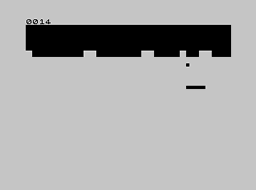
In one case a while back,JS&A was (in my opinion RIGHTLY) enjoined from making what was, in effect, a dedicated device solely for pirating ATARI game cartridges. BUT the REASONS the judge gave for the decision were incredibly stupid and actually DANGEROUS in the precedent they might set.. The cretinous chimpanzee in his black robes alledged that ROM software shoul N OT enjoy the federal protection to right to back up beacuse it was more dureble than Mag Media software. ROM's ARE quite vulnerble to be zapped, and SHOULD be legal to back up all you want. Though in this case JS&A was rightly stopped from amking a piracy machine, it was for the WRONG reasons. (in my opinion.)
As I say... the questsion is a difficult one. But the folks at Tandy have VERY tiny minds, and will only try something if the competition has tried it first. They have always lacked the brains to innovate themselves. And lacked te guts. Hence the botch job they did with teh 6809. (The M100 was only a PARTIAL exception).
If I sound contemputous of the cretinous chimps in Fort Worth, you got it right! They are and always will be copiers, second raters, and also rans. And their current policy will guarantee them a continguing measure of moderate success, but will also guarantee that they will never make any great new contributions to computing.

Apple II Incider - Donkey Kong and Pac-Man by Donald Lee
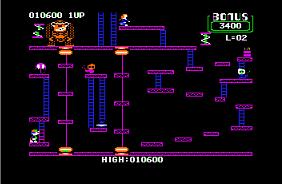
Happy New Year to everyone! As I write this, Christmas and New Year's has come and gone. I hope everyone had a safe and sane holiday. I got a little sick during the past week, but fortunately, I am over it and getting ready for what should be a busy week at work.
FOr this month's issue, I decided to revisit a couple of old classics in Donkey Kong and Pac Man. These games have convered extensively in the past so I'm not going to try and duplicate what was published before. Instead, I will try to write about my impressions about the Apple II versions of these games because (believe it or not), I NEVER played the Apple II versions of these games in my youth!
Let's start off with Donkey Kong. My first exposure to Donkey Kong was obviously in the arcades. I enjoyed the game, though I wouldn't say it wasn't among my top 5 favorites. So, I personally wasn't clamouring for a version of Donkey Kong for home. However, as most of us know, Atarisoft released versions of Donkey Kong for various machines including the Apple II (interestingly, the Atari 5200 never got a version). However, I never came across the Apple II version of Donkey Kong and never had an inclination to look for it.
Thanks to the various Apple II emulators available today, I was able to give the Apple II version of Donkey Kong a run and I was impressed. The graphics, music and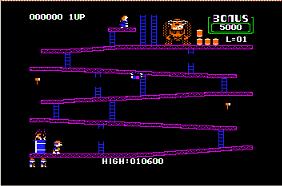 sound of the Apple II version are obviously inferior to the original arcade version. However, I found the game quite playable though at level 1, the game seemed easier than the arcade version. While the sound and music are inferior, I thought they didn't detract from the overall game play.
sound of the Apple II version are obviously inferior to the original arcade version. However, I found the game quite playable though at level 1, the game seemed easier than the arcade version. While the sound and music are inferior, I thought they didn't detract from the overall game play.
My experience with Pac Man is opposite of Donkey Kong. It was one of the early arcade games I played and remains one of my favorites. While I don't play it much today, I definitely had a love for all things Pac Man in my youth and looked forward to home versions of the game. My exposures to the home version of Pac Man include the horrible Atari 2600/VCS version (at the stores) and the much improved Atari 5200 (and computer) version which I played extensively.
Because I played Pac Man so much on my Atari 5200, I never looked to play the game on my Apple II in my youth. Playing the game on my Apple II emulator for the first time was an interesting experience. The layout of the screen and graphics were recreated reasonably close to the arcade version. As Alan Hewston noted back in Retrogaming Times (way back when), the Apple II version went with the arcade style maze display versus the wider display of the other versions, which gave the game a true to arcade feel. The game played relatively well as well, despite the white Pac-Man.
I was a little disappointed with the sound/music in the Apple II version. I mentioned that the inferior sound in Donkey Kong didn't detract from the game playing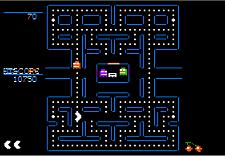 experience too much. However, much of the charm in the arcade version of Pac Man was in the sound and music. While it isn't the fault of Atarisoft that the Apple II had limited audio capabilities, the missing sound and music was noticable to me.
experience too much. However, much of the charm in the arcade version of Pac Man was in the sound and music. While it isn't the fault of Atarisoft that the Apple II had limited audio capabilities, the missing sound and music was noticable to me.
While each of these games have some weaknesses, for Apple II fans during the 1980's, these were the best you were going to get. While each of the games are not perfect, Atarisoft did do a reasonable job and each is worth checking out for the nostalgic value of it.
In the months to come, I hope to cover some of the Atarisoft offerings. I've already mentioned Robotron 2084 and Centipede in the past, but hope to cover the other games that were available. See you next month!
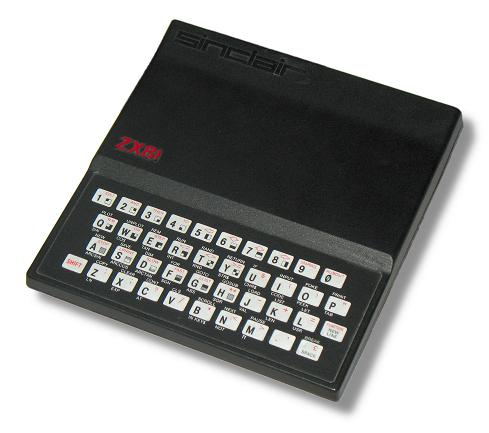
The Thrill of Defeat: Catching the 1k Bug by Mark Sabbatini
To appreciate history's greatest game programming feat, try explaining the rules and strategies of chess in less than 150 words.
David Horne did better, teaching a computer to play chess in about that many keystrokes. Lest anyone question its abilities, it recently caught me napping and put me in check after two moves (see screenshot).
Other programmers using the same machine proved to be miracle workers, bringing sound to the deaf and sight to the blind. But the masses ultimately flocked to flashier and more attractive idols, leaving only a few devout souls to carry on the legacy.
As 2009 begins, I'm resurrecting a column from a year or so ago about gaming on the world's most pitiful computers and consoles. I do so not in mockery of their wretched owners since I'm a lifelong fan of also-rans from Trash-80s to Macs. Also, no matter how awful the machine, there's always a few titles on them every retrogamer ought to try and I promise to feature at least one every month (noted with an asterisk).
In keeping with the spirit of the Baby New Year, the restart begins with the near infancy of computing viability: the Sinclair ZX81.
Most retrogamers are likely familiar with Clive Sinclair's tiny econobox from the U.K. and its U.S. twin the Timex-Sinclair 1000 (I've owned several, including a Timex still in excellent condition). For those that aren't, the ZX81 debuted in 1981 as the first "consumer" computer retailing for less than £50 ($100 in the U.S.), albeit in kit form it cost £20 more assembled. It looks more like a toy than a machine as it's roughly a six-inch square in size and less than two inches thick. It has a 32X24 black-and-white uppercase display, a whopping 64X48 graphics resolution, no sound and a flat membrane keyboard whose 40 miniscule "keys" lacks a real spacebar.
The base machine has 1K of RAM and stores data on cassettes at 250 baud, a speed so slow it can take 10 minutes to load a 16K program with the £30 ($50) expansion pack attached. The tape interface is hypersensitive to volume and flutter, so loading often takes several tries. The memory pack's connection is so poor it frequently crashes at the slightest nudging of the machine (and sometimes not even that). It also has perhaps the slowest functional speed of any computer sold to the masses since three-fourths of the processing time is used generating the display. Users can get marginally acceptable speed with a selectable FAST mode, which blanks the screen during any computer function such as keystrokes and calculations. One reviewer actually praised the madly flashing screen that results, saying it serves as a substitute for tactical feedback when typing.
Why, oh why, did I spend a measurable portion of my adolescence using such a wretched device?
For starters, it was all I could afford in my early teen years and getting busted at Sears with some Colecovision carts under my jacket convinced me I was a lousy shoplifter. Luckily the Brits, having survived worse indignities such as beans on toast for breakfast, wrung unforeseen potential out of what many called the world's first disposable computer. Among their efforts: 64K memory packs with reliable connections, games with high-resolution graphics, music composers, a program that supposedly generates illusions of color and in the modern age internet server hookups.
At the start, however, was just what they could wring out of that 1K of memory, which is where this review of ZX81 games begins. Grades are relative only to the 1K ZX81 since they''re markedly inferior to almost any 16K Sinclair title and in a different universe than games for other machines (for starters, text characters are commonly used instead of graphics). Players may also notice most games are crammed into small parts of the upper screen, a necessity since the ZX81 has no separate display memory filling the 32X24 screen with text consumes 768 bytes and leaves virtually nothing for programs.
For the sake of simplicity and immediate gratification this month's reviews are limited to a brower-emulated collection at www.zx81stuff.org.uk/index.html featuring many of the major (and minor) titles available back then. Frankly, nearly everything in this roundup except 1K Chess is awful but be patient some impressive 1K titles, including recent homebrew releases, playable with emulators on nearly any computer will be reviewed next month. Think of this month as a chance to experience the frustration of many juveniles who blew their allowance on hapless titles foisted onto them by sellers/companies with no-preview, no-return policies intended to thwart copying. The result, of course, was many innocent souls (including me) resorted to mass piracy to find the few programs worth paying for.
A few tapes listed in the browser emulator are skipped (such as those in French), which shouldn't be a big deal since many of these games have a lot in common. Instructions and other materials are available below the emulator window, although most use the awkward 5-8 keys for movement (thanks to Sinclair's decision to use those SHIFTed keys for cursor movement) and 0 for fire.
10 Games (D)
This is representative of most 1K collections: a few arcade games, a few strategy games, a drawing program and a kaleidoscope all the quality of a quick magazine type-in program or what any reasonably competent BASIC programmer could write in an hour or so. First and foremost, those so-called action games are absurdly slow. Two are the ubiquitous avoid-scrolling-obstacles exercises, the first featuring Klingons and the second where the player is always moving right unless (s)he presses a key to move left. A few games use a similar one-key approach, making them easier to play and slightly different than most such packages. The strategy games include (unauthorized) versions of Simon, Mastermind and two-player hangman. To demonstrate the relative value of this better-than-many collection, a couple of the many quirks: the drawing program has no crash protection if you use too much of the screen and a lunar lander program is text only the acceleration and distance to the surface is listed, and the player presses a key to slow the rate of decent. I vaguely remember seeing the latter on programmable calculators and a build-it-yourself cardboard-case Heathkit from the 70s with a single-line LED display and 256 bytes of memory (see 1K Chess for a similar example).
1K Games Pack (D+)
Arctic Computing was one of a few companies known for consistently good Sinclair software, so this 11-game collection is a good choice for those not wanting to plod through a dozen "tapes" for something worth playing more than once. There's clunkers such as a slot machine and a scrolling driving game with a too-small playfield, but also some that are more than duplicates of programs found on other tapes. Among them is a strategy-oriented endless scrolling maze and a one-key shoot-the-approaching-wall game (think a very slow and simplified version of the cone stage in Tron).
*1K Chess (A)
Horne's effort is considered legendary and ranks as the second-best title in an all-time ZX81 users' poll, so how can this grade be ay lower despite some significant shortcomings? The computer AI is beginner-level competent, with a magazine comparison of ZX81 chess games rating it five out of 10 (the best earned a nine, but all would get their chips kicked by nearly any program on another computer). The pieces on Horne's tiny board are represented by letters rather than graphics ("P" for pawn, "Q" for queen, etc.), but Sinclair's in-house chess game does the same and requires 16K (it got a six for playing ability). The lettering is not too hard to get used to and the game can always be played out on a real board. The computer checks to make sure the player (who is always black) makes legal moves and puts on an entertaining display as the moves it is considering with flashing letters. The limited AI is somewhat redeemed by moves that are fairly quick (advanced programs of the era can take 10 hours or more per move). The biggest drawback is the program doesn't recognize castling or capturing en passant, but the grade here doesn't suffer given the impossibility of including them given the memory limits (a version for the unexpanded 2K Timex/Sinclair 1000 includes these moves). The only nick is for the number-letter notation for entering moves (7E5E as an opening pawn move, for instance) instead of the conventional letter-number approach, which resulted in some early frustration and seems correctable without using additional memory.
Games 1 (F)
An absolutely must-try for those wanting an overdose of the epilepsy inducing FAST mode. All six games are common BASIC exercises such as yet another scrolling meteor field to avoid. Optimists can pretend the strobe-like display is the result of a malfunction in the ship's navicomputer, or something. The game Sniper places a man on the screen and the player types a number from one (far left) to zero (far right) based on what they think his relative position is. Golf involves making shots by typing in a club strength of 35-75. There's a mini simulation of the cell-generating Life program. And so on. It's a lot like having no life and a migraine you don't realize how great an empty but painless existence is until you're in a lot of pain.
Program Pack 4 (F)
The two breakout varieties on this tape are marred by mediocre gameplay and poor collision detection. The first is the traditional block-at-a-time incarnation with three allowable "misses" where the ball bounces off the bottom of the playfield (apparently simpler to program than a new ball). The second game, Brikthru, gives the player one ball that knocks out everything in its path to the top of the screen and back after every paddle hit. The problem is the program frequently doesn't recognize the paddle hitting the ball so games end prematurely regardless of the player's skill. Anyone with an average understanding of BASIC could equal or surpass these programs easily.
Super Nine (D-)
Oh, the agony of so much undelivered potential. The list of programs is impressive simple versions of Scramble, Defender and Asteroids among them and they're among the very few to use machine language instead of BASIC. This permits dozens of skill levels, even if most are unplayably fast. The problem is most of the games crash when you try to play them. Canyon is a typical scrolling/avoidance game, only wicked fast with 50 skill levels and a high score function. Asteroids is an interesting left-to-right avoidance exercise, again with multiple levels for speed and asteroid density. As the first two games on the tape they offer a promising, if unoriginal, start. But subsequent action titles such as Astroblaster, Scramble and Defender all crashed, while other titles such as two-player squash (pong) and Connect Four clones are little different than competitors' tapes. It's remotely possible the crashes are due to a bug in the browser's emulator, but since grades are based on how games play with it there's no choice but to knock this potentially worthwhile title back to the pack.
Super Programs 1-4 (D)
I wrote separate reviews for each of these tapes, but there's so much similarity there's no point in wasting your time reading them. Each is an unremarkable collection of six programs usually consisting of a couple of "action" titles, a couple of strategy games, a drawing program and a conversion calculator. SP2 is probably the best of the lot with a mildly intriguing Escape From Saturn game where the player has to reach the top or bottom of an obstacle course in a limited number of moves, a Boggle-type word generator and a guess-the-"word" (actually random letters) memory game with three skill levels. The drawing program on SP3 is probably the best since it allows players to draw with an character, not just a lo-res black line. Pretty much everything else is an exercise in cloned program vapidness.
Super Programs 7 (D+)
No, I didn't get bored and skip a few tapes SP 5 and 6 are for 16K machines. The break did International Computers Ltd. some good as there's a smidgen more variety and quality than their previous efforts. Racetarck is a typical scrolling driving game, but a rare one in that it uses the entire screen. Golf generates a random nine-hole course that is modestly amusing, with player entering clock directions (1-12) and power (1-9) as club strokes. Chase, where a mine-laying robot chases the player on a small field, has potential since the player is faster than the robot but can only move in four directions the robot moves in eight), but death is inevitable regardless of skill once too many mines are placed. Tip: Load the collection's second link on the browser page (with the black, red and white cassette cover) since the first one doesn't include instructions.
Tapebook 50 (F)
Quantity does not equal quality, especially in a collection like this where there's too much lousy stuff from a gaming perspective to make it worth sorting through. Most of the programs do various calculations such as loan interest payments or logarithms. The games are simplistic, even by the standards here. The only reason to try this is to see what kind of "other" programs are in books from the late '70s and early '80s that feature dozens or hundreds of generic BASIC type-in listings.
Next month: Zaxxon, Frogger, Tetris, an RPG adventure and an emulator in 1K?
| Game Over |
Okay, as with all good things, this issue has come to an end. It was a LOT of fun putting it together, getting the images to sit right, making sure the icons for each article looked good, and making sure that all of the paragraphs spaced out the way I wanted them. I saw a LOT of things coming together, and saw some plans as to how I want to fix a few things later. I thank all of the writers for their AWESOME submissions. This issue was just a wonderful experience at getting my feet wet.
When I grew up reading magazines like EGM, and GamePro, I wanted to be a journalist for one of them. Being the Editor-in-Chief just didn't seem to be a plausible thing, let alone the journalist part. However, thanks to advent of the internet, we all have the ability to step into the shoes of what we dreamt of doing. Just as we do when we press "start" and begin our adventures as space cadets, dragon slayers, or race car drivers, this ezine has given me the chance to be the "big cheese" of a popular video game magazine.
Thank you for reading!